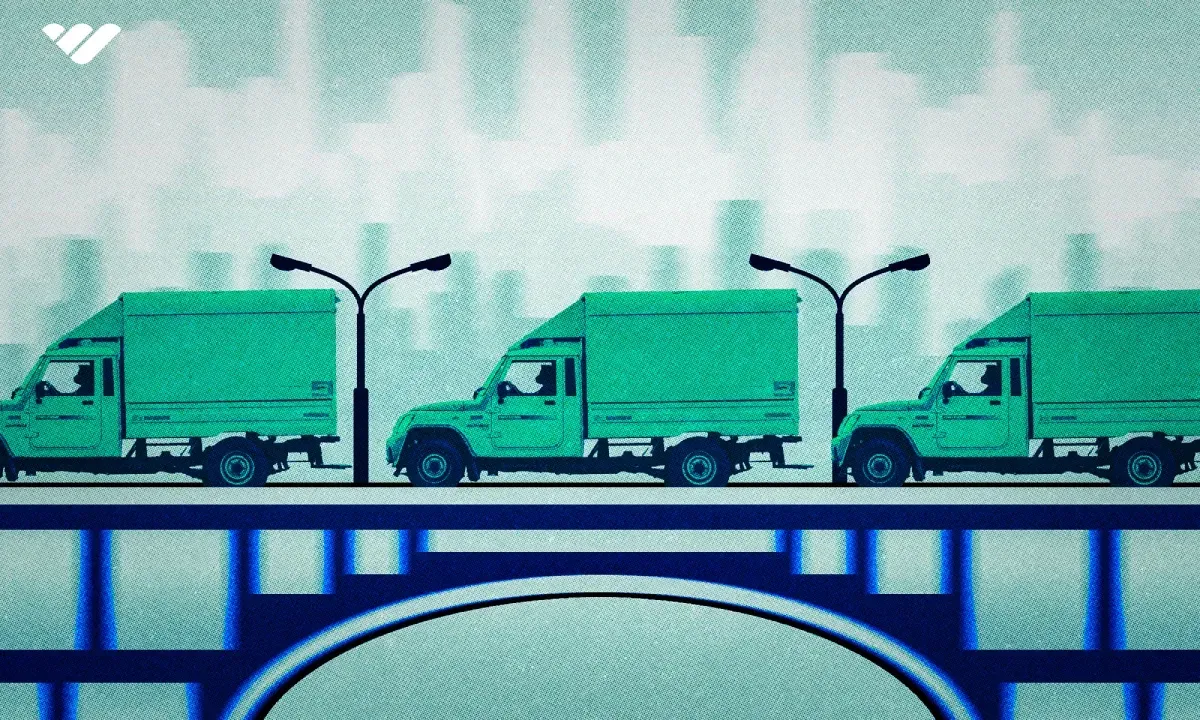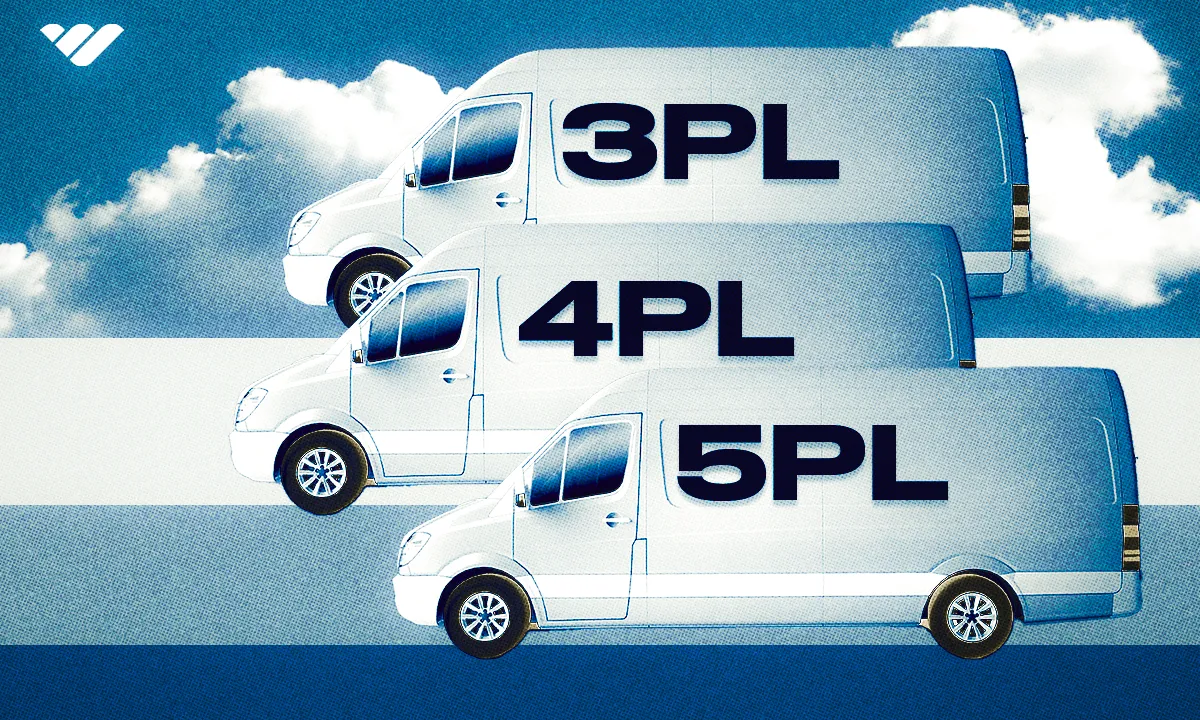3PL, 4PL, and 5PL - what's the difference? Read this article to find out.
Key takeaways
- 3PL providers handle warehousing, inventory management, and transportation for businesses.
- 4PL companies act as consultants that coordinate multiple 3PL providers and logistics networks.
- 5PL providers leverage AI and technology to manage entire supply chain operations.
- Asset-based 3PLs own vehicles and warehouses while non-asset based use carrier relationships.
- Higher-level logistics models cost more but provide greater supply chain integration and efficiency.
If you’re new to ecommerce, it’s common to look for a logistics provider that can help you with your business. However, the industry has quite a lot of jargon that can be difficult to understand, especially for those just getting into logistics.
One example here is logistics. There are a handful of logistic models, such as 3PL, 4PL, 5PL, and more. So, we’ve broken down what these terms mean, how they work, and whether it’s right for you.
Looking at the Fundamentals: 1PL and 2PL
These days it's more common to hear about 3PL, 4PL, and 5PL, but it’s important to start with the basics: 1PL or first-party logistics. This means the manufacturing company transports goods from one location to another with its own in-house fleet, operational team, and even customer service.
1PL is beneficial because you get an overview of each process in the logistics process. This could be an option for companies and small businesses which have just started and have a limited number of customers. When you start out with 1PL you can always scale up once your business has grown to a certain extent.
Moving onto 2PL, which refers to second-party logistics, this is where an external carrier/logistics company is responsible for moving your goods around. This can be through road, rail, water, or even air, but what’s important to remember is, they’re in charge of transportation. So your team can focus on other aspects of your business and leave the delivery to 2PL providers. However, it does mean you won’t have the same control over deliveries or delays as you would with the 1PL model.
Today, logistics has moved way beyond these two concepts and evolved to the point where we have 3PL, 4PL, and 5PL.
What Does 3PL or Third-Party Logistics Mean?
3PL (third-party logistics) is just a level above 2PL, which means part of the supply chain or the entire supply chain is outsourced to an external company. Some common services 3PL logistics can help with are:
- Coordinating with several carriers on your behalf
- Storage and warehousing
- Managing inventories and returns
- Packing goods/ exports or grouping shipments
- Forwarding freight and more
Depending on the 3PL provider you choose, you can see what services they provide. So, using this type of logistics model means you already have an established transportation network and experienced teams you can take advantage of. Plus, it’s more cost-effective in the long term since these companies can negotiate better prices.
But this means you’re now further away from your supply chain, so there’s less control over what can happen.
Asset-Based 3PL Vs Non-Asset Based 3PL
There are two types of 3PL models: asset-based and non-based, but some companies use a combination of the two.
As the name suggests, asset-based 3PLs own their assets, such as vehicles, warehouses, etc. On the other hand, non-asset-based 3PLs utilize their established relationships with carriers, airlines, haulers, and more to transport your goods.
Both can be advantageous depending on your company, but if you’re confused between the two, you can also pick in-between providers.
Pros and Cons of 3PL
If you’re considering using 3PL providers, you can save costs for warehousing, shipping, and other aspects since they already have established relationships they can leverage for negotiation. One of the key benefits of 3PLs is they provide the flexibility of scaling up or down operations without the need to set up new infrastructure. Also, since they provide multiple services, you have a portfolio of diverse options from which you can pick and choose what you need.
However, there are some downsides to having a 3PL provider, because as we’ve already explained, you’re losing control over your supply chain. As a result, it can be difficult to respond to sudden disruptions effectively as you’ll have to communicate with an external party. This is crucial because if you’re unable to keep the level of communication going, it can lead to further delays. Compared to the other two options, it doesn’t provide any real-time visibility or tracking capabilities that would be useful for optimizing the supply chain.
Understanding 4PL or Fourth-Party Logistics

Adding to the 3PL layer, 4PL, or fourth-party logistics (also known as lead logistics providers) act as consultants for your supply chain needs. They are in charge of establishing your network of 3PL providers along with any digitalization requirements.
The consulting firm Accenture coined this term in the 1990s and defined 4PL as "a supply chain integrator that assembles and manages the resources, capabilities, and technology of its own organization with those of complementary service providers to deliver a comprehensive supply chain solution."
Suppose you have different providers for warehousing, freight forwarding, transportation, etc. 4PL companies will be the middlemen between you and all these other logistic businesses. As a result, you’ll be relieved of co-ordinating with various carriers.
4PL providers can help establish your logistic network, and they are usually connected to experienced carriers. Essentially, they take the burden off your internal teams for any transport or logistic-related issues by becoming the single point of contact.
Pros and Cons of 4PL
When you’re working with 4PL providers, you can focus more on your business and rely on them to keep your supply chain going. Since 4PLs have a full overview of the supply chain, you’ll find that they can identify new efficiencies within your company. Plus, you have more visibility than you have from 3PLs since you only have a singular point of contact that controls the supply chain. As a result, all parties, such as distributors and suppliers participating in the supply chain, might find it easier to work together.
Still, since 4PLs handle so many parts of the logistics network and have the power to establish it, they can add more complexity to the supply chain. Since they’re responsible for so much, they can be slightly more expensive than 3PLs. If you’re a company that wants to keep its sourcing and logistics processes hidden from rivals, it can be that 4PLs might reveal those. Although your agreement with the 4PL may include non-disclosure and even a non-compete, your business can be exposed to certain risks that it needs to take precautions against.
- Best Products to Sell Online in 2024 – Whop’s Ultimate Guide
- Ways to Improve Customer Experience: What Ecommerce Business Owners Need to Know
- 101 Best Ecommerce Business Ideas
5PL or Fifth-Party Logistics: What is it?
Unlike 3PL or 4PL, the 5PL model is a newer concept in this industry that takes it one step further. 5PL companies essentially act as a one-stop solution for larger supplier networks rather than just specific supply chains.
They will handle all aspects of supply chain management, such as organizing, planning, and implementing their logistics solutions. 5PLs leverage blockchain, robotics, artificial intelligence (AI), etc., to increase productivity and efficiency across the business.
In fact, a 5PL company can also manage other 3PL and 4PL providers so they can negotiate prices and offer you more cost-effective solutions.
Pros and Cons of 5PL
5PLs have the upper hand when it comes to integrating technology and AI into the supply chain, compared to 3PL and 4PL. These solutions allow for better efficiency and more optimized logistic processes, improving overall business output. Since 5PLs have an overview of the supply chain, they can provide a tailored approach to optimizing the latter as a whole.
As this is a newer concept, there are still some hiccups when working with a 5PL. In terms of cost, 5PLs are much more expensive than the other two options since they offer a more personalized level of service. Furthermore, they add another layer of complexity on top of what a 4PL does. Your company also has a higher level of dependency on 5PL providers because they act as an extended part of your company.
What are the Differences between 3PL, 4PL, and 5PL?
Now that we’ve discussed the concepts of 3PL, 4PL, and 5PL in-depth, it’s time to highlight their major differences with a brief overview.
| 3PL or Third Party Logistics | 4PL or Fourth-Party Logistics | 5PL or Fifth-Party Logistics |
|---|---|---|
| Manages carriers and delivery services such as warehousing, order fulfillment, etc. | Handles multiple 3PL providers or sets up the logistics network. | Takes care of all the company's supply chain needs. |
| For asset-based 3PLs, they own their vehicles. | Often tends to outsource transport services to other providers. | Act as intermediaries between 3PL companies and shipping. |
| At times, only focuses on one aspect of logistics, so multiple 3PLs might be needed. | Assembles your logistics network to make sure all operations are done smoothly. | Looks at the supply chain overall and integrates technology into the process. |
| Less expensive as you can choose which services you want to outsource. | They are more expensive than 3PLs since they act as a consultant service. | Comparatively more expensive since it's responsible for the entire supply chain on its own. |
| Can negotiate costs for shipping for cost benefits. | Builds relationships with 3PLs and other providers to bring down costs. | Responsible for negotiating contracts across the board, so they can reduce costs overall. |
| Only works on managing and executing logistics services. | Offers strategic advice and consultations. | Works towards improving efficiency within the supply chain and what 3PLs and 4PLs do. |
| Best for companies whose supply chains are too complex or only need certain aspects outsourced. | Best for ecommerce businesses that deliver goods worldwide. | Best for growing e-commerce companies with a variety of supply chains but also focusing on efficiency. |
The Future of Supply Chain Logistics: 6PL, 7PL and Beyond
With more developments in the world of supply chains, newer terms such as 6PL and 7PL have been popping up everywhere. Although neither of these terms has a set definition yet, let’s explore the concepts for these models.
Starting with 6PL or sixth-party logistics, this model is said to be a data or AI-driven supply chain, which will be an upgrade from 5PL. It is said that 6PL will look at resource allocation and efficiency in terms of sustainability. So, you can consider 6PL to be the supply chain from an environmental point of view as well.
On the other hand, the name 7PL or seventh-party logistics comes from merging 3PL and 4PL logistics, where all aspects of your supply chain are outsourced. Although this sounds similar to the 4PL model, the difference is that 4PLs don’t own any assets, so that’s where 3PLs come into play( specifically asset-based 3PLs). So, you have all aspects of your supply chain under one umbrella.
Apart from these two, many more emerging concepts have gone as far as 10PL or tenth-party logistics. However, you should know that these have not been realized or set in stone yet. Therefore, there’s still time for these logistics aspects to integrate more with technology, so it’s best to focus on today's options.
Which Logistics Model Should You Choose: 3PL, 4PL or 5PL?
Up until now, 3PL has become the popular and tried-and-true logistics model for smaller and larger ecommerce businesses alike. However, 4PL and 5PL models are important for looking toward the future, as they also focus on finding efficiencies and leveraging technology and automation.
In the end, there’s no clear winner when choosing a specific logistics model. You should focus on your business needs, and you might find that a mix of some of these models works best for you. So, consider how much of your supply chain you want to outsource, connect with other businesses, and weigh out all options before choosing.
If you're looking for more ecommerce advice, tips, and education, check out the ecommerce category on the Whop marketplace for courses, communities, and tools to help you on your journey.



